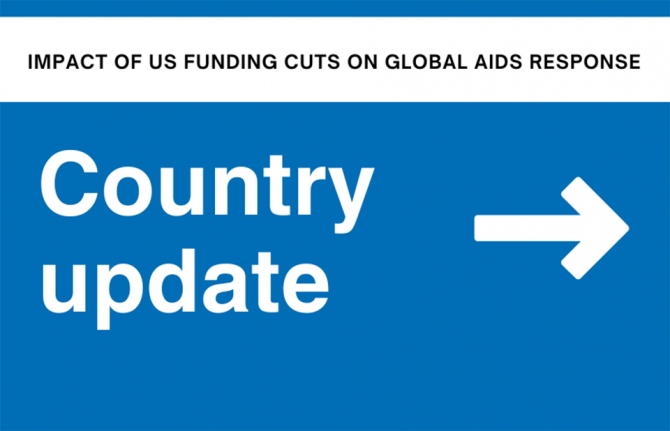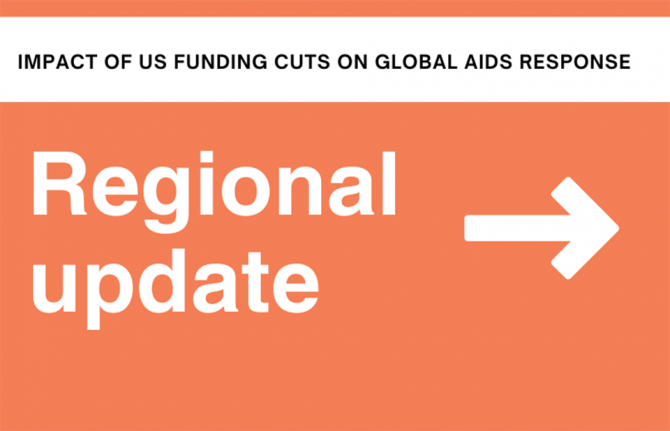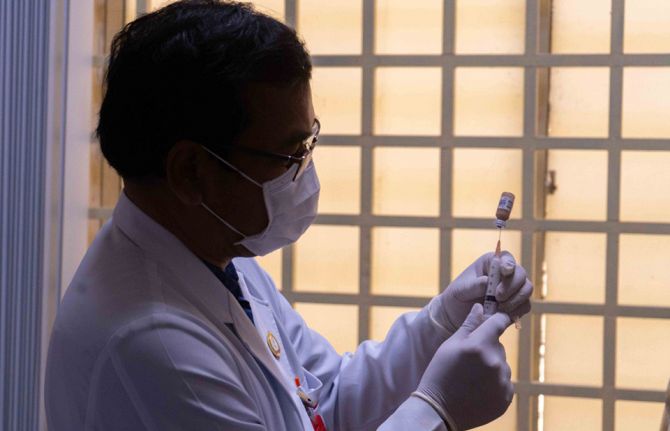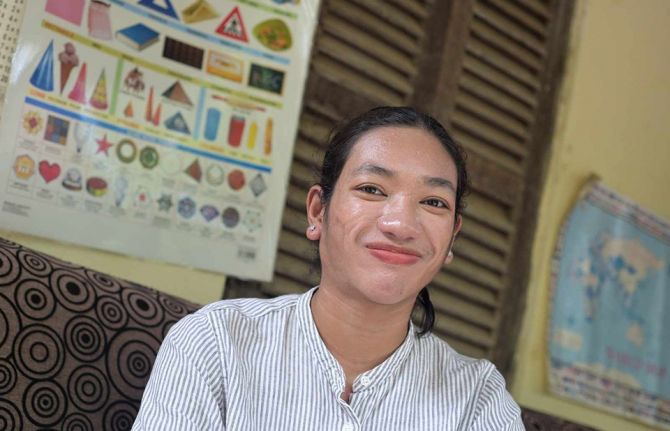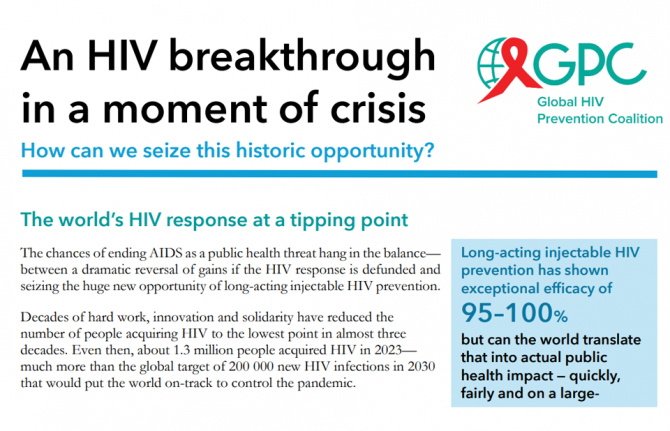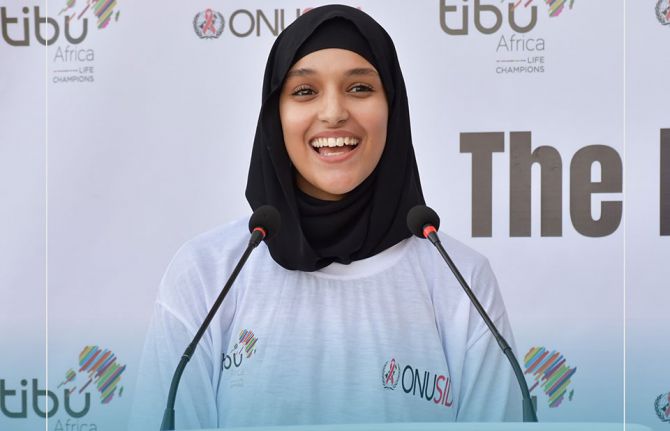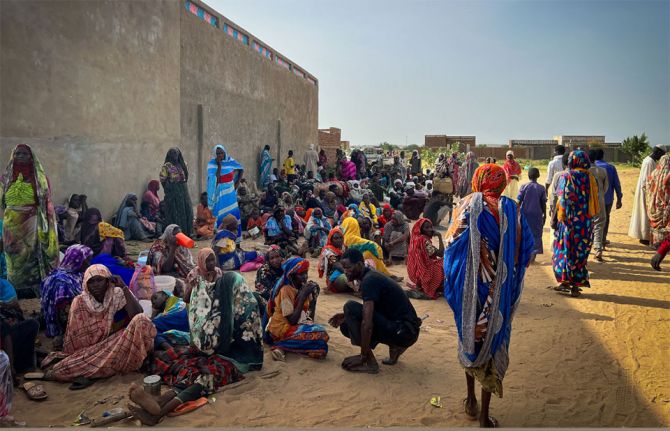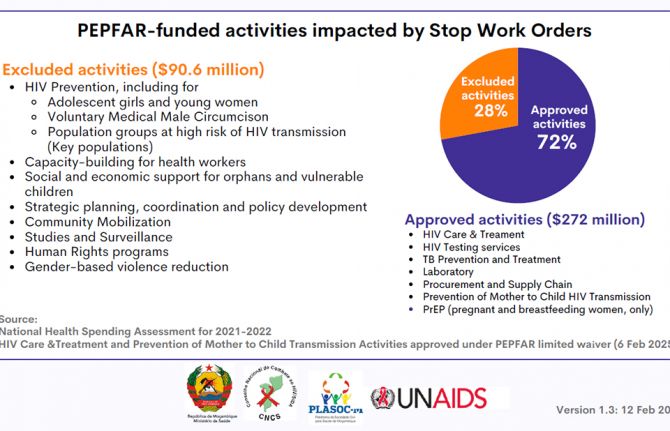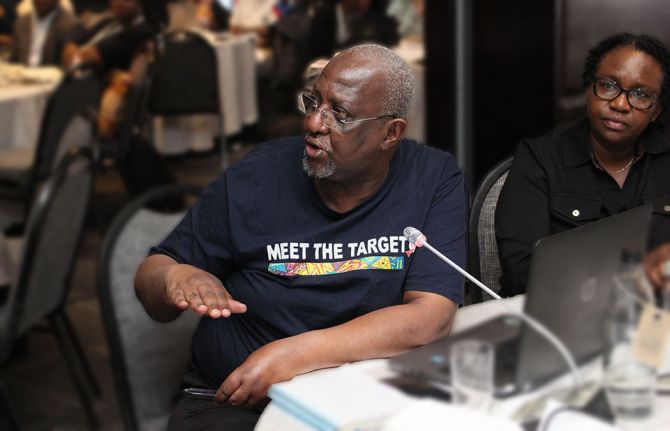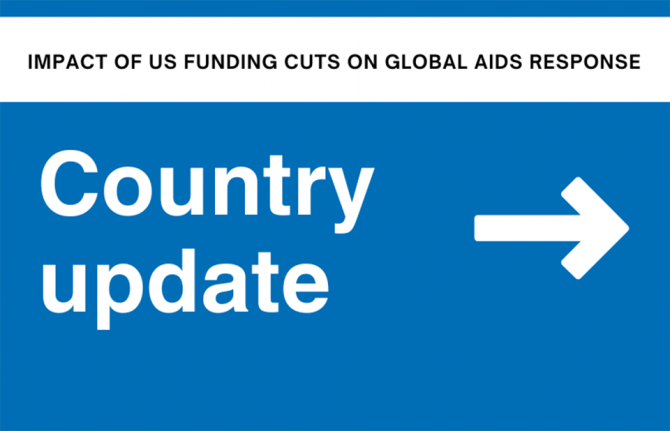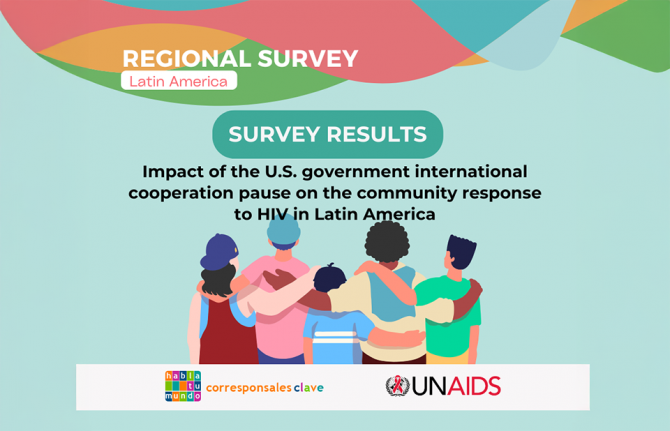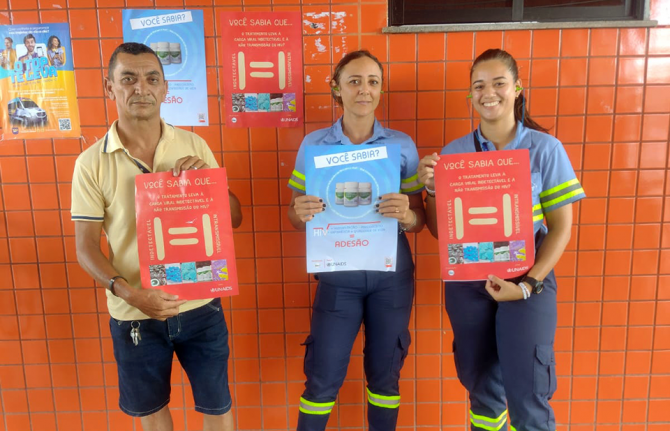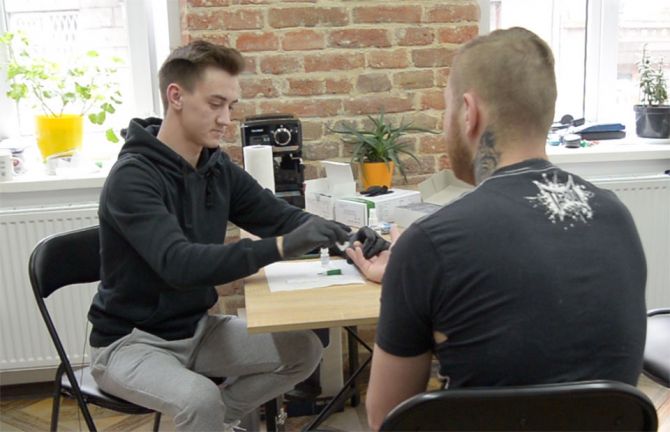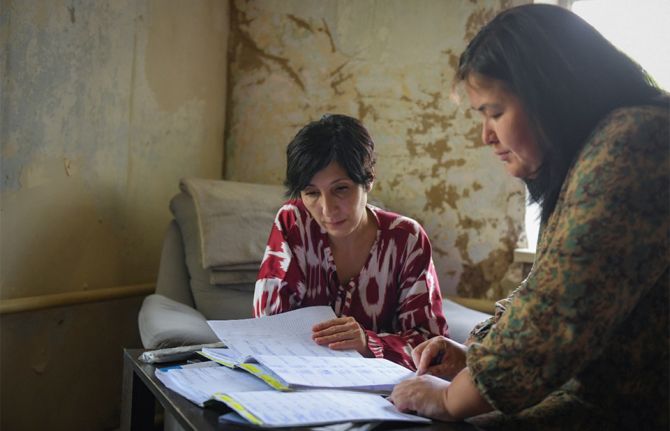
Feature Story
New report calls for $25 billion investment to ensure countries reach 2010 targets
10 February 2009
10 February 2009 10 February 2009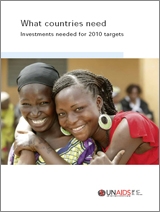
“What countries need: Investments needed for 2010 targets”
A new report released by UNAIDS, "What countries need: Investments needed for 2010 targets," estimates that an investment of US$ 25 billion will be required for the global AIDS response in 2010 for low- and middle-income countries—US$ 11.3 billion more than is available today.
“It will not be easy to close this gap but it is achievable and absolutely necessary if we are to accelerate the pace of the response to the AIDS epidemic,” said UNAIDS Executive Director Michel Sidibé.
The investment needs is based on the country-defined targets to reach universal access to HIV prevention, treatment care and support by 2010. The new report anticipates that nearly one third of this investment will come from domestic sources, with investments from multilateral and bilateral sources needed for the remaining US$ 17 billion.
The report highlights that, of the total investments required, approximately one third is for activities addressing behavioural change, social drivers of the epidemic, social mitigation and other services that are managed outside of the health sector through multisectoral programmes.
Another one third is aimed at strengthening health systems. The weakness of health systems is a major obstacle to scaling up to universal access to prevention, treatment, care and support.
The remaining one third will go towards HIV specific health services, such as programmes to reduce mother-to-child HIV transmission, blood safety, and provision of antiretroviral therapy for those in need.
HIV prevention, treatment and care
It is estimated that nearly US$ 11.6 billion will be required for HIV prevention and US$ 7 billion for treatment.
We cannot let the economic crisis paralyze us. Stimulus packages and economic adjustments should be made with a human face in mind. A mother should not have to choose between continuing AIDS treatment and feeding her children. We cannot let down the 4 million people on treatment and millions more in need today.
UNAIDS Executive Director Mr Michel Sidibé
The priority HIV prevention services chosen by countries are based on UNAIDS prevention guidelines, which call on countries to prioritize programmes according to the type of national epidemic. For example, countries with generalized epidemics have an urgent need to scale up prevention services for young people. Whereas countries with concentrated epidemics are advised to focus first on providing services and programmes to the most-at-risk populations, including sex workers, their clients, injecting drug users, and men who have sex with men.
The investments needs for treatment and care cover more than the provision of antiretroviral treatment. Besides including costs for antiretroviral treatment, they also include provider initiated testing and counseling, treatment and prophylaxis for opportunistic infections, nutritional support, laboratory testing, palliative care and the cost of drug-supply logistics. The costs for CD4 testing to monitor the response to antiretroviral therapy and disease progression are also included.
What can be achieved with the $25 billion?
With the achievement of country-defined targets of HIV-related services, in 2010 approximately 6.7 million individuals would be receiving antiretroviral treatment. More than 70 million pregnant women will be screened and receive prevention of mother-to-child transmission services; 20 million men who have sex with men, 7 million sex workers and 10 million people who inject drugs will receive HIV prevention services. Seven million orphans will be supported and nearly 8.1 billion condoms (male and female) distributed. This will result in averting 2.6 million new HIV infections, cutting HIV incidence by nearly 50% and averting 1.3 million deaths.
Achieving country-defined targets by 2010 presents an opportunity to change the pace of the response to the AIDS epidemic. It will help save lives—by putting more people on treatment, protecting babies and young people from getting infected, and ensuring that a whole generation of orphans will graduate from school. It will also build the foundation for sustaining the AIDS response for years to come, as well as contributing to the strengthening of health systems and increasing human resources. It will help reduce homophobia, stigma and discrimination, especially of the voiceless and marginalized. It will contribute to reducing violence against women and girls and empowering millions to protect themselves from HIV and sexual abuse.
It is clear that in today’s financial climate, investments must be made wisely. But the human face must be kept in mind; behind each reduction or cutback is an individual, a family.
“We cannot let the economic crisis paralyze us,” said Mr Sidibé. “Stimulus packages and economic adjustments should be made with a human face in mind. A mother should not have to choose between continuing AIDS treatment and feeding her children. We cannot let down the 4 million people on treatment and millions more in need today.”
As the report concludes, universal access has to become a reality for the hundreds of millions of people who are vulnerable to HIV infection and the millions of people living with HIV and their loved ones. Investments already made in responses to AIDS are showing results. This is a time for scaling up, not scaling down.
Right Hand Content
Press centre:
New executive director sets universal access to HIV prevention, treatment, care and support as top priority for UNAIDS (10 February 2009)
Fact sheet: Investment needs (pdf, 38.1 kb)
Fact sheet: AIDS funding 2008 (pdf, 37.7 kb)
Publications:
What countries need: Investments needed for 2010 targets (pdf, 550 kb)
Related

Feature Story
UNAIDS Executive Director visits South Africa
09 February 2009
09 February 2009 09 February 2009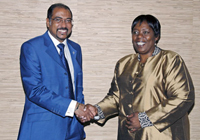
UNAIDS Executive Director Michel Sidibé (left) met with the Deputy Speaker of Parliament Mrs Nozizwe Madlala-Routledge on 9 February 2009 in Capetown.
Credit: UNAIDS/G. Williams
The Executive Director of UNAIDS, Mr Michel Sidibé, is visiting South Africa where he will announce plans for the future direction of the Joint United Nations Programme on HIV/AIDS (UNAIDS).
This morning in Cape Town he met with the Deputy Speaker of Parliament Mrs Nozizwe Madlala-Routledge.
Tomorrow he will outline his strategy for the future direction of UNAIDS during a speech in the South African township of Khayelitsha where he will be joined by the Minister of Health Hon. Ms Barbara Hogan.
Building on the commitment countries have made to reach universal access by 2010, Mr Sidibé will set out his strategy and highlight the need to invigorate global momentum, action and commitment towards achieving universal access to HIV prevention, treatment, care and support.
He will also outline the investments needed for countries to reach their targets for 2010.
This is the first official country visit Mr Sidibe has undertaken in his new role as Executive Director of UNAIDS.
South Africa currently has the largest number of people living with HIV in the world—approximately 5.7 million and HIV prevalence in adults aged 15 to 49 is 18%.
Related

Feature Story
Goodbye to another hero in the AIDS movement Ramesh Venkataraman
06 February 2009
06 February 2009 06 February 2009By Leonard Okello
International head of HIV/Aids, ActionAid
I have received the very sad news of the sudden death of Ramesh Venkataraman, the former ActionAid Asia HIV and AIDS regional coordinator. Ramesh joined ActionAid in April 2007 till he resigned his post at the close of 2008. He passed away on 31 January due to an internal haemorrhage. He had been suffering from multiple illnesses.
Over the last two years that I have worked with Ramesh, he touched my heart and became literally like my younger brother. He had—and will continue to have—a special place in my heart. We shared in depth both official and personal challenges and opportunities.
Ramesh had a deep passion for his work and a special love for ActionAid. He always stood up for Human Rights and fought injustice straight on, but his health frustrated him more and more as the days passed by. He always told me how much he knew of his abilities, but was getting increasingly frustrated by his physical strength failing him. He feared to fail the team that he loved so much and had a sense of responsibility that often drove him to tears of pain and hope depending on the context.
Ramesh was immensely intelligent, and had super advocacy skills with a range of media, cameras, drama, information technology, and a rich humorous language, something that fate never allowed him to fully utilize.
When we last met together in Delhi, Ramesh informed me that he feared his body was giving up. He resigned about two weeks thereafter. We kept in touch on and off although the phone lines were often not really friendly. Last time Ramesh and I talked on phone briefly he was very hopeful following a knee surgery.
But like my mother often told me, when a patient gives you a lot of hope, then you know it is about time to prepare for the worst. Human life, she always told me, lives on hope and it is hope that must keep you going till you rest at the end.
There is something else I learnt from the comrades of the African National Congress (ANC) and at college in Uganda, during the anti-apartheid struggles. "Do not mourn, Comrades, Mobilize!" was the slogan that kept them moving during tough times.
I am seeking of each and every one of the global AIDS movements across the world, to use this time of reflection to mobilize even more to deal with HIV and improve our health.
Please keep the fire that Ramesh kept burning so that we can deliver on whatever he left behind not yet done. Let us complete the struggle for human rights as passionately as he would have loved too.
May his soul rest in eternal peace. Aluta Continua! Solidarity!!
Right Hand Content
External links:

Feature Story
Talking about OneLove in Southern Africa
06 February 2009
06 February 2009 06 February 2009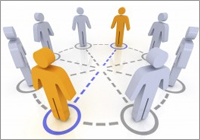
Credit: OneLove campaign
“Talk, respect, protect”
OneLove is a regional campaign running in Southern Africa that aims to get people talking about the trend of having more than one sexual partner at a time. The overall goal is change this behaviour which is a factor in the transmission of HIV in the region.
Using mass media and social mobilisation to communicate its message, OneLove encourages people to discuss multiple partnerships and come to greater understanding of the risks involved in their lifestyle choice.
Multiple partnerships and concurrent relationships
Close sexual networks are formed when men and women have multiple sexual partners or concurrent relationships—ongoing relationships with more than one intimate partner overlapping for weeks, months or years. If someone in this network acquires HIV it increases the chance of everyone else who is part of this network becoming infected.
OneLove national campaign South Africa
The South Africa OneLove campaign was launched on 14 January. With outreach to 16 million South Africans, the prime-time TV drama series “Soul City” and the “Soul City” radio drama are key vehicles to get the message out to people across the country. UNAIDS is a partner of the Soul City Institute which aims to promote healthy lifestyle choices through mass media advocacy.
The OneLove theme is also being featured on radio talk shows, through TV and radio advertisements and a number of outreach events. Over a million information booklets will also be distributed in multiple languages.
The overall goal of the campaign is to reduce the number of new HIV infections in South Africa by 10% by 2011. This will contribute to the goal set by the South African National AIDS Council (SANAC), which aims to reduce the number of new HIV infections in South Africa by half in a couple of years.
South Africa has the largest number of HIV positive people in the world with some 5.7 million people living with HIV in the country and HIV prevalence in adults is 18%. Campaigns that inform people of the potential risks of their lifestyle empowers people to make informed decisions about their sexual behaviour
Catherine Sozi, UNAIDS Country Coordinator
“South Africa currently has the largest number of HIV positive people in the world with some 5.7 million people living with HIV in the country and HIV prevalence in adults—age 15 to 49—is 18%. Campaigns that inform people of the potential risks of their lifestyle empowers people to make informed decisions about their sexual behaviour,” said UNAIDS Country Coordinator Catherine Sozi.
Social networking to discuss sexual networks
As well as mobilizing traditional media, OneLove is also employing social networks to highlight the issue of sexual networks. The campaign features on a range of social networking and new media fora including video sharing site YouTube, the Flickr shared photo gallery, a Facebook page and Twitter feed.
Participation and sharing of ideas is at the core of the campaign. The OneLove official website (http://www.onelovesouthernafrica.org) hosts, in addition to lots of information resources and fact sheets, a weekly competition and blog. Everyone is invited to comment on articles, add their views on a discussion board and take the online polls.
The HIV epidemic in Southern Africa
The severity of the epidemic in southern Africa—nine countries in the region account for 35 per cent of all HIV infections in 2007—underscores the need for intensified and accelerated action towards universal access to HIV prevention, treatment, care and support.
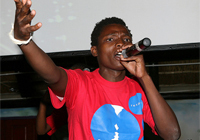
OneLove signature tune performed at the community launch of the OneLove South Africa campaign in Ubuntu Kraal in Orlando West, Soweto on the 24 January 2009.
Credit: OneLove campaign
UNAIDS has identified HIV prevention as a particular priority and it highlights the importance of reducing HIV incidence through a combination of prevention approaches. Combination strategies include education and raising awareness in relation to delayed sexual debut, increased condom use, male circumcision and reduction in numbers of concurrent relationships. The OneLove campaign is an important vehicle for this.
Right Hand Content
Partners:
External links:
OneLove
South African National AIDS Council (SANAC)
Tools:
OneLove on Flickr
OneLove on Facebook
OneLove on Twitter
OneLove on YouTube

Feature Story
New information-sharing portal for tracking and evaluating AIDS responses
05 February 2009
05 February 2009 05 February 2009
Monitoring and Evaluation systems and activities are key to tracking what is being done in HIV prevention, treatment and care and whether these activities are making a difference.
Credit: globalhivmeinfo.org
Monitoring and Evaluation (M&E) systems and activities are key to tracking what is being done in the field of HIV prevention, treatment and care and whether these activities are making a difference. A new platform (www.globalhivmeinfo.org) now allows M&E professionals worldwide to access and share information about the AIDS epidemic and the response in a ‘one-stop-shop’.
The webportal includes an extensive and continuously growing number of documents and resources for download in a digital library, interactive calendars of events and training activities and news flashes. The users are able to quickly find information and tools by searching the portal or the digital library, or can tap the wealth of information available on M&E-related sites throughout the internet by using the portal’s external search engine.
The new webportal is a powerful one-stop-shop for information and resources on the M&E of the AIDS epidemic and response. It is a way for M&E professionals to gain exposure to exciting new M&E information, as well as share their own work with the global M&E community.
Deborah Rugg, UNAIDS Chief, Monitoring and Evaluation Division
Additional features of the portal are social bookmarking functions and automatic alerts and RSS feeds. It also provides mechanisms for communicating with other M&E professionals and its collaborative features enable users to create virtual teams and workspaces. “The webportal is a powerful ‘one-stop-shop’ for information and resources on the M&E of the AIDS epidemic and response. It is a way for M&E professionals to gain exposure to exciting new M&E information, as well as share their own work with the global M&E community,” said Deborah Rugg, UNAIDS Chief, Monitoring and Evaluation Division.
A collaborative effort
The M&E webportal is the product of collaboration among various international agencies that focus on M&E for HIV-related programs, and its purpose is to serve M&E professionals working in local, national, and global capacities. These include field officers placed in-country by international partner agencies; their country counterparts working in national, regional, and local government agencies and non-governmental organizations; staff located at headquarters of international partner agencies; and other practitioners interested in M&E of AIDS programs.
Towards strengthening the “Third One”
As a platform for information exchange within the M&E community working on AIDS with its many partners and actors, the webportal also contributes to strengthening the “Third One” - One agreed country-level Monitoring and Evaluation System - and to ensuring that monitoring and evaluation approaches are coordinated and are generating reliable and timely information on the epidemic and the response.
Right Hand Content
Contact:
To request additional information or to submit a question or comment, please e-mail: admin@globalhivmeinfo.org
Tools:
Related
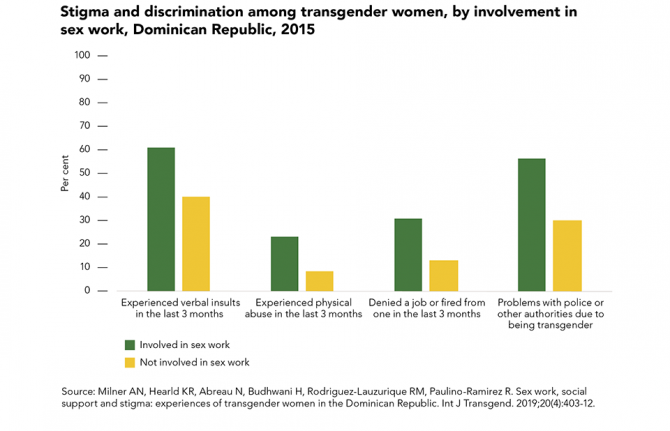 Transgender sex workers face frequent abuse
Transgender sex workers face frequent abuse

29 March 2022
 Many key populations avoid health services
Many key populations avoid health services

21 February 2022

Feature Story
Insight into AIDS responses in Middle East and North Africa
04 February 2009
04 February 2009 04 February 2009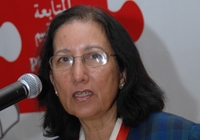
Dr Renu Chahil-Graf, Director, UNAIDS Regional Support Team for the Middle East and North Africa
Credit: UNAIDS
Across North Africa and the Middle East, UNAIDS estimates that 35,000 people acquired HIV in 2007, bringing to 380,000 the number of people living with HIV. An estimated 25,000 died of AIDS-related illness in the same year. Effectively coordinated HIV prevention, treatment, care and support strategies are vital to the reduction of these figures.
In order to get a clearer picture of the challenges to leading and coordinating an AIDS response in the Middle East and North Africa (MENA) regions, an assessment of the National AIDS Coordinating Authorities (NACA) in 16 countries was recently carried out by the UNAIDS Regional Support Team.
“Having insights into the strengths of their national responses helps country partners identify opportunities for improved coordination,” said Dr Renu Chahil-Graf, Director, UNAIDS Regional Support Team for the Middle East and North Africa.
“Equipped with this information, countries are better informed to make decisions leading to the shared goal of universal access to HIV treatment, prevention, care and support services for those in need,” she continued.
National AIDS Coordinating Authorities assessment

Ministers and High Level Government Officials from MENA countries
Credit: UNAIDS
The assessment looked at institutional structures, governance, relationships between coordinating bodies, capacity strengthening, harmonization and alignment and operational challenges and made a series of recommendations.
Based on the review, UNAIDS convened the first regional meeting on national AIDS coordination in collaboration with the Sultanate of Oman last month in Muscat.
More than 80 participants representing directors of national AIDS programmes, senior health and other government officials from the Sultanate of Oman, Algeria, Egypt, Iran, Jordan, Lebanon, Morocco, Palestine, Saudi Arabia, Somalia, Sudan, Syria, Tunisia, United Arab Emirates and Yemen took part in the three day meeting. Representatives of WHO, UNDP, UNFPA, World Bank and the Global Fund to Fight AIDS, Tuberculosis and Malaria for HIV (Global Fund) also attended.
Insights into the strengths of their national responses helps country partners identify opportunities for improved coordination. Equipped with this information, countries are better informed to make decisions leading to the shared goal of universal access to HIV treatment, prevention, care and support services for those in need.
Dr Renu Chahil-Graf, Director, UNAIDS Regional Support Team for the Middle East and North Africa
Bringing together Ministers of Health, Ministers for Youth and Sports as well as Ministers of Social Services, the interactions facilitated cross-sectoral approaches to moving the AIDS responses forward.
“Three Ones” principles
Across the globe everyone is agreed on the need to use valued resources more effectively. Coordinated and harmonized partnerships are key to making this happen. This has resulted in an agreed set of principles introduced by UNAIDS. These “Three Ones” are shaping international and national initiatives on AIDS.
Implementing the Three Ones nationally requires National AIDS Coordinating structures to be involved in the following areas:
- Leading the development of prioritized National Strategic Plans;
- Strengthening monitoring and evaluation systems that facilitate oversight and problem solving for the national programme;
- Leading participatory reviews of the performance of stakeholders in harmonizing and aligning their support to the national programme.
"Sharing Experiences on the Three Ones Principle in Action in the Middle East and North Africa" was the theme of the three day meeting. In addition to reviewing the results of the assessment, country specific roadmaps for the coming year were developed.
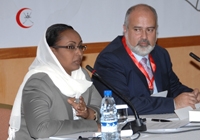
H.E Hasna Barkat Daoud, Minister of Youth, Sports and Tourism, Djibouti (left) chairing a session with Mr Elie Aaraj, President of the Regional Network of AIDS NGOs in the Middle East and North Africa
Credit: UNAIDS
Countries in MENA received approximately US$ 431 million from the Global Fund over the last four years. Recommendations for the revitalization of the national AIDS response in MENA were discussed in several different sessions and working groups and were recapitulated in the closing ceremony.
The universal access goal
“We are all aware that we are far from having achieved the universal access goal to make HIV prevention, treatment and care accessible for all those in need by 2010,” said Jihane Tawilah, WHO Representative and Chairperson of the UNAIDS Theme Group in Oman.
“In 2007, an estimated total of 150,000 people living with HIV were in need of antiretroviral therapy in the region. Those who received the therapy were only six per cent of this number, which is considered the lowest coverage rate among the WHO regions globally,” she added.
The priority in the region is to apply effective preventive intervention strategies and to increase the antiretroviral therapy coverage, she said, adding: “This will require re-examining our policies and practice and redirecting accordingly our efforts and resources to where we can achieve our universal access targets.”
Dr Chahil-Graf also highlighted the need to raise awareness about AIDS among the sections of society not yet reached by HIV prevention information.
Right Hand Content
Feature stories:
Gender and AIDS in the Middle East and North Africa (08 August 2007)
Increased HIV services for drug users needed (14 November 2006)

Feature Story
New tool distills guidance on writing strong Global Fund HIV proposals
02 February 2009
02 February 2009 02 February 2009WHO and UNAIDS resource kit for writing Global Fund round 9 HIV proposals
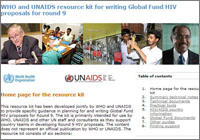
The resource kit has been designed to focus on the essential points which are presented in a user friendly way. The information is structured in a way that echoes the development of a proposal.
Credit: www.who.int
As applicants prepare their proposals for the next round of HIV funding, Round 9, UNAIDS and WHO have jointly developed an online resource kit to provide guidance in planning and writing strong Global Fund proposals.
The Global Fund to Fight AIDS, Tuberculosis and Malaria (Global Fund) is a financial mechanism that provides grants in support of evidence-informed, technically sound and cost-effective programmes for the prevention and treatment, care and support of persons infected and directly affected by HIV, tuberculosis and malaria. By 1 December 2008, it had signed grant agreements worth US$ 10.2 billion for 579 grants in 137 countries around the world.
The aim of the fund is to direct money to areas of greatest need so that a real difference can be made in peoples’ lives. As a part of this process hundreds of pages of technical documentation on how to design programmes or write a grant proposal have been developed by a range of technical experts. The challenge for the country partners writing their proposals is sifting through these myriad long and complex guidelines.
To simplify this, the resource kit has been designed to focus on the essential points which are presented in a user friendly way. The information is structured in a way that echoes the development of a proposal. It is aimed to be a practical tool that country partners can use with ease.
Given all the guidance that exists on the application process, a user-friendly web-based tool such as this one, structured to compliment proposal development, can enable a country to navigate the complexities of the process and develop a strong proposal
Nancy Fee, UNAIDS Country Coordinator, Indonesia
People are already finding it useful. “In the jungle of technical guidance for writing proposals that’s out there, communicating the unique relevance of this tool is the biggest challenge. However, country teams across this region have already begun to benefit from this important resource.” said Geoff Manthey, UNAIDS Global Fund regional focal point, Asia Pacific Regional Support Team.
Compilation of guidance
The content of the resource kit is a compilation of existing guidance developed by different technical agencies including UNAIDS, UNFPA, UNICEF and the World Health Organization. In preparation of the kit, the team reviewed Global Fund feedback on previous proposals and identified recurring weakness areas so that the content of this kit could address these.
“This toolkit is the result of close collaboration between WHO, UNAIDS, and other UN and civil society partners,” said Mazuwa Banda, Medical Officer, World Health Organization.
“We hope that it is widely distributed and, most importantly, used; and we will continue to work together to improve it in response to feedback from its users.”
It includes a number of technical guidance notes on cross-cutting issues relevant in the design of any HIV programme. These include gender, human rights and law, sexual minorities and social change communication. A number of notes on health systems strengthening are also included as well as guidance on specific intervention areas including HIV prevention, treatment, care and support.
There are also a number of practical tools included on managing the proposal development process including a planning matrix and costing tool.
Know your epidemic
Country data is vital to knowing a country’s epidemic in order to design an effective response. Statistics on HIV interventions, links to latest epidemiological fact sheets and other useful country information are also included in the resource kit.
Finding support
In addition to sharing guidance, the online kit includes a “Finding support” section which gives direction to assistance offered through WHO and UNAIDS as well as useful contacts and a list of focal points. While the response to and coordination of technical support to countries should be first addressed at country level within the UN theme group, WHO and UNAIDS can offer support by facilitating the proposal development process and providing general or specific technical guidance, to ensure that the proposal is technically sound and meets the other requirements. UNAIDS has established “Technical Support Facilities” across the world that help match countries technical assistance needs with most well suited technical assistance in the form of individuals and/or companies.
UNAIDS and the Global Fund
Given the complementary strengths and shared commitment to the global AIDS response, Global Fund and UNAIDS collaborate to accelerate progress towards universal access to HIV treatment, prevention, care and support services.
By offering a range of support to country partners to help applicants prepare strong proposals for Global Fund resources UNAIDS, as the United Nations coordinating programme on HIV, also helps to make the resources of the Global Fund work. UNAIDS also supports the Global Fund in monitoring and evaluating the performance of its grantees through strengthening the capacity of principal recipients and sub-recipients to report on grant implementation.
This collaboration is leading to real results on the ground as Nancy Fee who works in Indonesia as UNAIDS Country Coordinator notes: “As Indonesia has seen, a successful application to the Global Fund results in a grant that can make a huge difference to a country’s AIDS response.”
“Given all the guidance that exists on the application process, a user-friendly web-based tool such as this one, structured to compliment proposal development, can enable a country to navigate the complexities of the process and develop a strong proposal,” she added.
Right Hand Content
Cosponsors:
Partners:
The Global Fund to fight AIDS, TB and Malaria
Tools:
WHO and UNAIDS resource kit for writing Global Fund HIV proposals for round 9
Global Fund Round 9 Call for Proposals (Closing Date: Monday, 1 June 2009 – 12 noon CET)
Contact:
Please address any comments and observations you might have on this kit to: globalfund@unaids.org
Publications:
Memorandum of Understanding between UNAIDS and The Global Fund (pdf, 2.09 Mb)

Feature Story
In Memory of Allan Dunaway: Founder and President of Honduras National Association of people living with HIV
29 January 2009
29 January 2009 29 January 2009By Rodrigo Pascal, UNAIDS Partnerships Officer
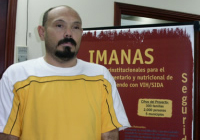
Allan Dunaway, Founder and President of Honduras National Association of people living with HIV.
It is indeed sad news to hear of the passing of Allan Dunaway who died in San Pedro de Sula, Honduras on 25 January 2009 at the age of 39.
Allan was one of the earliest AIDS activists in Latin America and he dedicated 18 years to supporting people living with HIV struggle for the right to treatment access in his country.
Allan and his beloved wife Rosa González were the first couple in Honduras to publicly declare that they were living with HIV. They were co-founders of Fundacion Llaves, which provides care and support for people living with HIV and Allan was the founding member and President for two consecutive periods of the Honduras National Association of people living with HIV. He was also the Chair of San Pedro de Sula National AIDS Forum.
Allan never doubted that he had to give a face to AIDS; and he made it clear from the beginning days of his activism that he had a responsibility to speak for those who had no voice.
Allan's wife Rosa González
The words of his wife Rosa resonate with my memories of Allan as being by nature a quiet person but who was determined to highlight important issues on behalf of others: “Allan never doubted that he had to give a face to AIDS; and he made it clear from the beginning days of his activism that he had a responsibility to speak for those who had no voice.” Allan was tireless in his efforts to make a difference. He reached out to local organizations and community groups building capacity and empowering them to organize events, marches and workshops. He also conducted workshops on managing funds and administration. He believed in the power of collaboration and worked hard to ensure that different organizations were informed of each other's activities and so strengthen the overall impact of their projects.
Allan was an assiduous advocate of human rights and worked closely with the National Commissioner for Human Rights to end discrimination against people living with HIV.
One of the proudest moments for Allan was to hear his 13-year-old daughter Keren deliver a breathtaking speech on behalf of young people living with HIV to thousands of delegates from around the globe at the opening of 2008 International AIDS Conference.
Allan also attended the High Level Meeting in New York in June 2008 when he and Rosa and a group of women living with HIV met with the UN Deputy Secretary-General.
Speaking of the loss, Richard Stern of Agua Buena Human Rights Association said: “Allan was a hero in a political struggle for human rights, but most of all he was a devoted husband and father. He will be sorely missed by all of us who worked with him for so many years.”
This is indeed a sad loss for Rosa and Keren. As a family, the Dunaways have been passionate advocates for universal access to care, support and treatment for those living with HIV, particularly in Latin America. I have no doubt Rosa and Keren by continuing their advocacy will keep Allan’s memory alive.
Right Hand Content
Feature stories:
AIDS 2008 opens (04 August 2008)

Feature Story
In Memory of Martin Delaney: The Founder of Project Inform
27 January 2009
27 January 2009 27 January 2009By Eric Sawyer, cofounder of ACT UP, Housing Works, Inc., & Health GAP, Inc.

Martin Delaney.
Last week we lost one of the true heroes in the response to AIDS. Martin Delaney, the founder and longtime Executive Director of the HIV advocacy/education organization Project Inform, died of liver cancer at his home near San Francisco on January 23, 2009. Marty Delaney was 63.
The world is truly a poorer place after the loss of Martin Delaney. Marty was on the front lines of the community’s response to AIDS from the very beginning of the epidemic. Marty was smart, sweet and quick to move to the side of social justice in any issue he confronted. His vision, energy and un-ending commitment contributed to the development of some of the first effective treatments for HIV opportunistic infections.
In 1985 Martin Delaney founded Project Inform, a national HIV treatment information, public policy and advocacy organization based in San Francisco. Marty created Project Inform because people living with HIV and their loved ones needed access to information to help save their lives; because people who were not infected needed information to stay that way; and because people who cared needed help organizing advocacy campaigns to push the government to find a sense of urgency and a new approach to finding treatments for HIV/AIDS.
Through his work at Project Inform Marty was one of the founders of the community-based HIV research movement and helped to ensure that HIV treatment education becoming widely available to patients, medical providers and anyone who cared worldwide.
He led in the movement to accelerate Food and Drug Administration approval of promising drugs and was a key player in the development of today’s widely used Accelerated Approval regulations and Parallel Track system for providing access to experimental drugs to seriously ill people prior to formal FDA approval.
Mr Delaney was a member of the National Institute of Allergy and Infectious Diseases (NIAID) AIDS Research Advisory Committee from 1991 to 1995, served on NIAID’s National Advisory Allergy and Infectious Disease Council from 1995 to 1998. On January 19 2009, Mr. Delaney received the NIAID Director’s Special Recognition Award for “extraordinary contributions to framing the HIV research agenda.”
In recent years, among many other activities, Mr Delaney led the Fair Pricing Coalition to improve access to HIV treatment, and advocated for an aggressive research agenda to find a cure for AIDS.
Of Marty’s passing, our mutual good friend Larry Kramer (ACT UP and GMHC Founder) said: “He was a great, great, great person. Every single treatment for AIDS is out there because of activists like Marty and Project Inform. I shall miss him very much. He was a dear friend and fellow fighter. He was a phenomenal leader, a brilliant strategist, and an indefatigable caretaker of us all.
For further information about Martin Delaney or Project Inform, please contact Ryan Clary at 415-558-8669 or rclary@projectinform.org.
Right Hand Content

Feature Story
Hidden HIV epidemic amongst MSM in Eastern Europe and Central Asia
26 January 2009
26 January 2009 26 January 2009
There is no doubt in the minds of health experts and activists that the official figures hugely underestimate the numbers of MSM living with HIV and newly acquiring HIV infection in Ukraine and elsewhere in the Region. Credit: UNAIDS/S.Dragborg
Judging by the official statistics, cases of HIV infection amongst men who have sex with men (MSM) in Ukraine, as in much of Eastern Europe and Central Asia, are so rare as to seem scant cause for concern.
“No statistics means no problem,” says Zoryan Kis of the All-Ukrainian Network of PLHIV (People Living with HIV). “The fact that the official numbers are very low is a danger for our work because we know that the epidemic exists but it is hidden.”
But there is no doubt in the minds of health experts and activists that the official figures hugely underestimate the numbers of MSM living with HIV and newly acquiring HIV infection in Ukraine and elsewhere in the Region.
In the 20 years since the first case of HIV infection was detected in Ukraine, only 158 MSM have been officially registered as living with HIV in a country with a total population of some 46 million people.
According to the 2007 UNGASS country report Ukraine has the most severe HIV epidemic in Europe, with just over 1.6 percent of the adult population estimated to be living with HIV. In 2007, 17,687 people were reported as newly infected with HIV, up 10 percent from 2006. Among them, the official number of new cases amongst MSM was just 48.
Together with the high degree of stigma attached to MSM in Ukraine, something the country shares with other countries in Eastern Europe and central Asia, this understating of the problem has contributed to authorities’ reluctance to back campaigns of prevention among MSM, activists say.
Beyond the official statistics, there is considerable data on MSM which paints a different picture. Various organisations, including UNAIDS, WHO and the International HIV/AIDS Alliance in Ukraine estimated that in 2006 there were between 177,000 and 430,000 MSM in the Ukraine, of whom between 3 and 15 percent of live with HIV, which is several hundred times the figure reflected in the official studies.
Most of MSM are not open. They would not go and say: ‘I have had sex with men’. They would say ‘I have had risky behaviour, I have been injecting drugs or even I have visited the dentist and I am worried
Zoryan Kis of the All-Ukrainian Network of People Living with HIV
Stigma and discrimination
Official HIV figures in Ukraine, as elsewhere in the region, are based on the results of voluntary HIV testing during which people should normally be asked why they have sought a test.
But in countries where MSM face widespread discrimination and where there is a high degree of stigma attached to male to male sex, there is understandable reluctance on the part of MSM to give the true reason.
“Most of MSM are not open. They would not go and say: ‘I have had sex with men’. They would say ‘I have had risky behaviour, I have been injecting drugs or even I have visited the dentist and I am worried,” says Kis.
And often officials do not press for answers. “I have been tested four or five times, but I have never been asked for my sexual orientation,” Kis adds.
According to the European Centre for the Epidemiological Monitoring of HIV/AIDS, only 1,828 cases of HIV infection in MSM have been officially reported between 2002 and 2006 years in the 15 former Soviet countries making up the World Health Organisation’s Eastern European health region.
Turkmenistan and Tajikistan, report none, while Azerbaijan has only 10 and Belarus 29. The highest number is reported by Russia; but its 1,245 cases over the 5 years compares with more than 38,000 in Britain and 11,000 in Germany in the same period, countries with smaller overall populations.
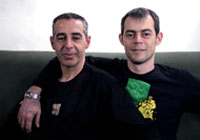
Prevention services for MSM have improved in the last few years, but they remain significantly inadequate to impact and sustain behavioural change and thus reduce HIV transmission among this group of men in Ukraine.
Credit: UNAIDS/P.Carrera
Ambitious goals
In 2006, Ukraine set ambitious national goals for scaling up towards universal access to HIV prevention, treatment, care and support for groups at high risk of HIV. However, HIV prevention activities in the Ukraine, as in most of the rest of the region, are carried out by NGOs with financial backing from international donors, mainly the Global Fund for AIDS, Malaria and Tuberculosis.
For example, a two-year project called “Men Who have Sex with Men: HIV/STI Prevention and Support” was implemented in Kiev by the AIDS Foundation East-West, the Gay Alliance NGO and Noah’s Ark-Red Cross Sweden, with financial support from the Elton John AIDS Foundation amongst others.
The International HIV/AIDS Alliance in Ukraine, which is co-holder of the Global Fund grants, is currently undertaking 14 projects aimed at HIV prevention among MSM. They include outreach services, provision of information and education around HIV and sexually transmitted infections (STIs), behavioural change communication, promotion of safer sex, condom and lubricants distribution, counselling and rapid-testing for HIV, testing and treatment of STI, self-help groups and anti-stigma trainings.
“The scale and scope of prevention services for MSM has improved in the last few years, but they remain significantly inadequate to impact and sustain behavioural change and thus reduce HIV transmission among this group of men in Ukraine,” says Dr. Ani Shakarishvili, UNAIDS Country Coordinator in Ukraine.
The situation is similar elsewhere in Eastern Europe and Central Asia. For example, there are no state-funded HIV prevention programmes for MSM in Russia.
“Governments everywhere are reluctant to spend money on sex workers, on drug users, but MSM comes at the top of the reluctance list. It is probably the last programmes that the governments will start,” says Roman Gailevich, UNAIDS Regional Programme adviser.

The new programme marks an encouraging change of stance by the government.
Credit: UNAIDS/S.Dragborg
For the first time
Under pressure from international donors and an increasingly vocal and better organised local MSM community, the Ukrainian Government recently agreed to include and set targets for HIV prevention and treatment for MSM as a priority in its National AIDS Programme for 2009-2013.
“This change stems from comprehensive surveys in the community which show the real role of MSM in the HIV epidemic in Ukraine,” says Anna Dovbakh, head of team: policy & programme development at the International HIV/AIDS Alliance in Ukraine.
“Since 2005, activists of the LGBT (Lesbian, Gay, Bisexual and Trans-sexual) community have become more active and professional in their HIV advocacy and response,” she adds.
Activists and health experts say that the new programme, which is currently before the Parliament, marks an encouraging change of stance by the government.
But the jury is out on what real difference it will make, not least because the money for HIV prevention will continue to come from the Global Fund and other donors.
“The lack of Governmental commitment to provide resources, support and services for MSM and to address the existing legal, financial and administrative barriers to service access for MSM indicates that the Government of Ukraine is still not fully prepared to address the HIV epidemic in MSM,” says Shakarishvili.
Right Hand Content
Feature stories:
China to tackle HIV indidence amongst MSM (16 January 2009)
HIV prevention hampered by homophobia (13 January 2009)
ICASA 2008: Men who have sex with men and HIV in Africa (07 December 2008)
MSM and the global HIV epidemic (31 July 2008)
Strengthening work with MSM in Africa (23 May 2008)
Global initiative to stop the spread of HIV among men who have sex with men (24 July 2007)
Press centre:
UNAIDS and broad coalition working towards the release of nine men who have sex with men in Senegal who have been convicted and imprisoned (15 January 2009)
Criminalization of sexual behavior and transmission of HIV hampering AIDS responses (27 November 2008)
Publications:
Practical guidelines on HIV prevention
Men who have sex with men, HIV prevention and care (pdf, 638 Kb)


